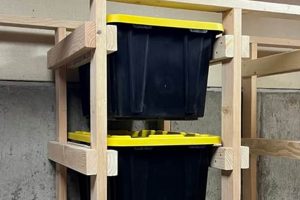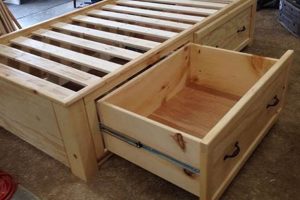A do-it-yourself queen-sized bed foundation incorporating integrated compartments represents a practical solution for optimizing bedroom space. This type of construction involves building a platform designed to support a queen mattress, with the added functionality of drawers, shelves, or other enclosed areas built into the frame. These compartments are intended for stowing items such as bedding, clothing, or personal belongings.
The value of such a construction lies in its ability to address space limitations, particularly in smaller living environments. It maximizes the use of vertical space beneath the bed, converting an otherwise unused area into a functional repository. Historically, utilizing space-saving furniture has been a common practice in areas with high population density or limited housing sizes, reflecting a continuing need to efficiently manage living quarters.
The following sections will delve into the key considerations for designing and building such a bed frame, including material selection, structural design principles, and strategies for incorporating effective storage solutions. The aim is to provide a clear pathway to achieving a functional and aesthetically pleasing result.
Construction Tips for a Queen Bed Frame with Integrated Storage
The following guidelines provide crucial information for successfully building a queen-sized bed frame incorporating storage solutions. Adherence to these principles will enhance structural integrity, maximize storage capacity, and improve overall project outcomes.
Tip 1: Material Selection is Paramount: Employ high-quality hardwoods such as oak, maple, or birch for structural components. Softwoods, like pine, may be suitable for less critical elements, but ensure proper joinery techniques are used to compensate for lower inherent strength. Consider the overall aesthetic and desired finish when making selections.
Tip 2: Accurate Measurement and Precise Cutting are Essential: Meticulously measure all dimensions before commencing any cutting. Utilize precision measuring tools and employ sharp blades for clean, accurate cuts. This minimizes errors that can compromise the structural integrity of the bed frame.
Tip 3: Prioritize Robust Joinery Techniques: Implement strong joinery methods, such as mortise and tenon, dovetail, or biscuit joints, to connect frame components. Screws and glue should be used in conjunction with these methods for added stability. Avoid relying solely on nails or staples for structural connections.
Tip 4: Reinforce Weight-Bearing Areas: Strategically reinforce areas that will bear the most weight, such as the center support and the corners of the frame. Employ additional bracing or thicker material in these areas to prevent sagging or failure over time.
Tip 5: Design Storage Compartments for Accessibility and Functionality: Plan the layout of storage compartments carefully, considering the types of items to be stored. Ensure easy access to all compartments and utilize quality drawer slides and hardware for smooth operation and durability.
Tip 6: Ensure Proper Mattress Support: Integrate a solid platform or closely spaced slats to provide adequate support for the queen-sized mattress. Insufficient support can lead to mattress wear and discomfort. The spacing between slats should not exceed 2-3 inches.
Tip 7: Incorporate Ventilation into Storage Areas: To prevent moisture buildup and mildew growth, incorporate ventilation into enclosed storage compartments. This can be achieved through the use of small ventilation holes or breathable materials.
Successful implementation of these techniques will contribute to a sturdy, functional, and aesthetically pleasing bed frame that effectively integrates valuable storage space.
The following sections will delve into specific design considerations and aesthetic finishing techniques.
1. Material Durability
Material durability is a critical determinant of the lifespan and overall value of a do-it-yourself queen bed frame incorporating storage. The selection of materials directly influences the structure’s ability to withstand the stresses of daily use, resist environmental factors, and maintain its aesthetic appeal over time.
- Hardwood Selection and Longevity
Employing hardwoods such as oak, maple, or birch for the primary structural components of the bed frame provides enhanced resistance to wear and tear. These materials exhibit a higher density and inherent strength, mitigating the risk of deformation or breakage under the weight of the mattress and occupants. For instance, an oak frame, properly constructed, can withstand decades of use with minimal degradation, whereas a frame constructed solely from pine may exhibit sagging or joint failure within a shorter timeframe.
- Plywood Considerations for Panel Components
When utilizing plywood for panels or storage compartments, the grade and core composition are significant factors. High-grade plywood with a void-free core offers superior stability and resistance to warping compared to lower-grade alternatives. Marine-grade plywood, treated for moisture resistance, is advisable in environments prone to humidity, thereby preventing delamination and structural compromise. The thickness of the plywood is also pertinent; thinner plywood may be suitable for non-load-bearing elements, while thicker panels are necessary for supporting weight within storage compartments.
- Fastener Quality and Corrosion Resistance
The type and quality of fasteners, including screws, bolts, and nails, are integral to the bed frame’s overall durability. Corrosion-resistant fasteners, such as stainless steel or coated screws, are particularly important in preventing rust and subsequent structural weakening, especially in environments with high humidity. Moreover, the selection of appropriate fastener lengths and diameters ensures secure connections between frame components, minimizing the risk of joint failure under stress. Insufficiently sized fasteners can lead to premature loosening and instability.
- Surface Finishing and Protection
The application of a durable surface finish, such as polyurethane or varnish, provides a protective barrier against moisture, scratches, and UV damage. These finishes not only enhance the aesthetic appeal of the wood but also contribute to its longevity by preventing environmental degradation. Regular maintenance, including cleaning and reapplication of the finish as needed, further extends the lifespan of the bed frame and maintains its structural integrity. A poorly applied or absent finish can accelerate wear and tear, ultimately diminishing the material’s durability.
The careful selection of durable materials, coupled with appropriate construction techniques and protective finishes, is paramount in creating a queen bed frame with integrated storage that withstands the rigors of daily use and provides lasting functionality. Failure to prioritize material durability can result in premature failure, necessitating costly repairs or replacements, ultimately diminishing the value and utility of the project.
2. Structural Integrity
Structural integrity is a paramount consideration in the design and construction of a do-it-yourself queen bed frame with storage. This concept refers to the ability of the bed frame to withstand applied loads and stresses without experiencing deformation, failure, or collapse. A bed frame lacking sufficient structural integrity poses a significant safety hazard and fails to fulfill its primary function of providing stable support for the mattress and occupants. The integration of storage components within the bed frame design introduces additional complexities that necessitate careful attention to structural reinforcement and load distribution. For example, poorly designed or inadequately supported storage drawers can compromise the overall structural stability of the frame, leading to sagging, instability, and eventual failure.
Achieving adequate structural integrity in a queen bed frame with storage necessitates employing robust construction techniques and selecting appropriate materials. Joinery methods such as mortise and tenon, dovetail joints, and the use of metal fasteners contribute to the overall strength and rigidity of the frame. Reinforcing critical areas, such as the corners and center supports, with additional bracing or thicker material is essential for distributing weight and preventing sagging. Material selection plays a critical role, with hardwoods like oak and maple offering superior strength and durability compared to softwoods. The type of mattress employed influences the design of frame support system. Memory foam mattresses distribute the weight better than innerspring mattresses and require fewer support slats. Each part has specific material so the frame need to adapt to ensure structural integrity.
In conclusion, structural integrity is an indispensable attribute of any DIY queen bed frame with storage. Neglecting this aspect can result in a hazardous and unusable structure. By adhering to sound engineering principles, employing appropriate materials, and implementing robust construction techniques, a structurally sound and durable bed frame can be achieved, providing safe and reliable support for years to come. Ensuring the structural integrity of the frame is an investment in safety, durability, and the long-term functionality of the storage bed.
3. Storage Optimization
Storage optimization, in the context of a do-it-yourself queen bed frame, directly pertains to the efficient and effective utilization of the space beneath and around the bed frame for storage purposes. The impetus behind integrating storage into a bed frame is typically driven by spatial constraints within the bedroom. The ability to store items such as bedding, clothing, or personal effects directly beneath the sleeping surface mitigates the need for additional storage furniture, thereby maximizing floor space. A poorly optimized storage design can diminish accessibility and negate the intended space-saving benefits. For example, drawers that are too deep or difficult to access render the storage impractical. Similarly, irregularly shaped storage compartments may limit the types of items that can be effectively stored.
The implementation of optimized storage within a queen bed frame necessitates careful planning and design. This includes determining the specific storage needs, considering the dimensions and accessibility of the storage compartments, and selecting appropriate hardware such as drawer slides and hinges. Real-world examples of optimized storage include bed frames incorporating pull-out drawers for clothing, lift-up platforms revealing concealed storage for bulky items like blankets or seasonal decorations, and integrated shelving for books or personal belongings. Such solutions must balance storage capacity with ease of use and structural integrity. The design and distribution of loads within the storage compartments must not compromise the stability or longevity of the bed frame structure.
Understanding the principles of storage optimization is of significant practical importance for individuals undertaking the construction of a storage bed frame. Failing to prioritize efficient space utilization can result in a cumbersome and ultimately ineffective design. While maximizing storage capacity is desirable, it should not come at the expense of accessibility, structural integrity, or aesthetic appeal. Successful storage optimization is achieved when the integrated storage complements the primary function of the bed frame, enhancing its utility and contributing to a more organized and visually appealing bedroom environment. Challenges in achieving optimal storage relate to design complexity and material availability. Overcoming these challenges is key to producing a functional and valuable piece of furniture.
4. Design Aesthetics
Design aesthetics, in the context of constructing a do-it-yourself queen bed frame with integrated storage, signifies the visual appeal and stylistic coherence of the finished product. It extends beyond mere functionality to encompass the principles of visual harmony, balance, and the integration of the bed frame with the overall bedroom decor. The aesthetic considerations influence the perceived value and satisfaction derived from the project. A well-designed storage bed frame enhances the room’s ambience, while a poorly executed design can detract from the space’s aesthetic qualities.
- Wood Species and Finish Selection
The choice of wood species and the application of a specific finish directly impact the visual character of the bed frame. Lighter woods such as maple or birch lend a contemporary, minimalist aesthetic, while darker woods like walnut or cherry evoke a more traditional or luxurious feel. The finish applied, whether a clear coat, stain, or paint, further defines the color, texture, and overall style. The finish must harmonize with existing bedroom furniture and the desired aesthetic. The selected wood will directly reflect the bed’s aesthetic so choose wisely.
- Hardware and Detail Integration
The selection of hardware, including drawer pulls, knobs, and hinges, contributes to the bed frame’s overall design aesthetic. Hardware styles range from minimalist and modern to ornate and traditional, each conveying a distinct visual message. The careful integration of these details, ensuring consistency in style and finish, enhances the cohesive visual appearance. For example, brushed nickel hardware complements a contemporary design, while antique brass hardware suits a more vintage aesthetic.
- Proportion and Symmetry
The principles of proportion and symmetry play a crucial role in creating a visually balanced and pleasing design. The dimensions of the bed frame, including the height, width, and depth of the storage compartments, should be carefully considered to ensure harmonious proportions. Symmetrical designs, where both sides of the bed frame mirror each other, often convey a sense of order and stability. Asymmetrical designs, on the other hand, can introduce visual interest and dynamism, provided they maintain overall balance.
- Integration with Existing Decor
A successful DIY queen bed frame with storage should seamlessly integrate with the existing bedroom decor. This requires careful consideration of color palettes, furniture styles, and overall room ambience. The design should complement the existing elements, creating a cohesive and visually harmonious space. Factors to consider include matching wood tones, coordinating hardware finishes, and incorporating design elements that echo the room’s existing style.
The design aesthetics of a DIY queen bed frame with storage represent a synthesis of visual considerations that elevate the project beyond mere functionality. By attending to the details of wood selection, hardware integration, proportion, and compatibility with existing decor, the creator can produce a piece of furniture that not only provides practical storage solutions but also enhances the overall aesthetic quality of the bedroom environment.
5. Assembly Precision
Assembly precision constitutes a critical factor determining the structural integrity, longevity, and functional efficacy of a do-it-yourself queen bed frame incorporating storage. It encompasses the accuracy and meticulousness employed during the construction process, from the initial cutting of materials to the final fastening of components. Deviations from precise assembly tolerances can compromise the bed frame’s stability, diminish its load-bearing capacity, and negatively impact the smooth operation of integrated storage mechanisms.
- Accurate Measurement and Cutting
Precise measurement and cutting of all frame components are fundamental to ensuring proper alignment and structural integrity. Inaccurate measurements lead to gaps, misalignments, and uneven weight distribution, potentially causing instability and premature wear. For example, if the side rails are not cut to the exact same length, the bed frame may exhibit a noticeable wobble or slant, compromising its structural soundness and comfort. These errors will reduce the bed’s long-term durability.
- Proper Joint Alignment and Fastening
The correct alignment and secure fastening of joints are essential for creating a robust and stable structure. Misaligned joints weaken the overall frame, making it more susceptible to failure under stress. Similarly, inadequate fastening, such as using screws that are too short or improperly tightened, can compromise the joint’s strength. A real-world instance involves drawers that fail to run smoothly because they are not aligned correctly. If the joints are not correctly fastened, the structure will be weak.
- Hardware Installation and Functionality
Accurate installation of hardware components, such as drawer slides, hinges, and support brackets, is crucial for ensuring the smooth and reliable operation of integrated storage mechanisms. Misaligned drawer slides, for example, can cause drawers to stick, bind, or fail to close properly. Similarly, improperly installed hinges can result in doors that sag, scrape, or do not latch securely. The long-term effectiveness of the storage functions relies on appropriate installation.
- Squareness and Levelness Verification
Verifying the squareness and levelness of the bed frame during assembly is essential for ensuring its stability and preventing undue stress on the structure. An out-of-square frame can lead to uneven weight distribution, causing some areas to bear more load than others, potentially resulting in sagging or failure. A non-level frame can create discomfort and instability, making it difficult to sleep comfortably. Precise assembly will result in long-term, even weight distribution.
In conclusion, assembly precision is an indispensable aspect of constructing a DIY queen bed frame with integrated storage. Diligence in measurement, cutting, joint alignment, hardware installation, and squareness verification directly contributes to the bed frame’s structural integrity, functional efficacy, and long-term durability. Neglecting assembly precision can lead to a compromised structure that fails to provide adequate support, exhibits functional issues, and ultimately falls short of its intended purpose. Prioritizing accuracy throughout the assembly process is a key investment in the quality and longevity of the finished product.
Frequently Asked Questions
The following questions address common concerns and misconceptions regarding the construction and utilization of queen-sized bed frames incorporating integrated storage solutions. The information provided aims to offer clarity and guidance based on established principles of woodworking and furniture design.
Question 1: What is the optimal height for a queen bed frame with storage to maximize accessibility without compromising comfort?
The optimal height for a queen bed frame incorporating storage is generally between 18 and 24 inches from the floor to the top of the mattress. This range provides adequate clearance for most individuals to enter and exit the bed comfortably while also providing sufficient space for effective storage beneath the mattress platform.
Question 2: What joinery techniques are most suitable for ensuring the structural integrity of a storage bed frame?
Mortise and tenon joints, dovetail joints, and reinforced butt joints utilizing screws and glue represent the most robust joinery methods for ensuring the structural integrity of a storage bed frame. These techniques provide superior strength and resistance to racking forces compared to simpler methods like nailing or stapling.
Question 3: How can ventilation be effectively incorporated into enclosed storage compartments to prevent moisture buildup and mildew growth?
Ventilation can be integrated into enclosed storage compartments by incorporating small ventilation holes or utilizing breathable materials such as perforated panels or mesh fabrics. Placement of ventilation features should promote cross-ventilation to effectively dissipate moisture and prevent mildew accumulation.
Question 4: What type of mattress support system is recommended for a storage bed frame to ensure proper weight distribution and prevent mattress sagging?
A solid platform or a system of closely spaced slats (typically no more than 2-3 inches apart) provides optimal mattress support for a storage bed frame. Solid platforms offer uniform support, while slats allow for some degree of airflow and flexibility. Both options should be constructed from durable materials to prevent sagging over time.
Question 5: How should the weight of stored items be distributed within the storage compartments to minimize stress on the bed frame structure?
Weight should be distributed evenly throughout the storage compartments to minimize stress on the bed frame structure. Heavier items should be placed closer to the center of the frame and distributed across multiple compartments rather than concentrated in a single location. Overloading individual compartments should be avoided to prevent sagging or structural damage.
Question 6: What type of finish is best suited for protecting a wooden storage bed frame from scratches, moisture, and UV damage?
Polyurethane or varnish finishes offer excellent protection against scratches, moisture, and UV damage for wooden storage bed frames. These finishes form a durable, water-resistant barrier that protects the underlying wood from environmental degradation. Multiple coats may be necessary to achieve optimal protection and aesthetic appeal.
In summary, the successful construction and long-term performance of a queen bed frame with integrated storage hinge on careful planning, meticulous execution, and adherence to established principles of design and construction.
The following section addresses alternative approaches to building and acquiring such a bed frame.
Conclusion
This exploration of the “diy queen bed frame with storage” concept has elucidated critical aspects of its design, construction, and functionality. Key points encompass material selection, structural integrity, storage optimization, aesthetic considerations, and assembly precision. Each facet contributes significantly to the overall success and long-term utility of such a project. Failure to address any of these areas adequately can compromise the structural soundness, storage capacity, or aesthetic appeal of the finished bed frame.
The construction of a queen bed frame with integrated compartments presents both opportunities and challenges. The potential to maximize space utilization and customize a bed frame to specific needs and preferences warrants careful consideration. Prior to commencing such a project, rigorous planning, meticulous execution, and a thorough understanding of woodworking principles are essential for achieving a satisfactory and durable outcome. Furthermore, assessing available skills, resources, and time constraints is prudent to ensure project feasibility.







![Build Your Own! Storage Bin Rack DIY Project [Easy] The DIY Hub: Creative Crafts, Repairs & Life Hacks Build Your Own! Storage Bin Rack DIY Project [Easy] | The DIY Hub: Creative Crafts, Repairs & Life Hacks](https://craftingdiycenter.com/wp-content/uploads/2025/07/th-1825-300x200.jpg)